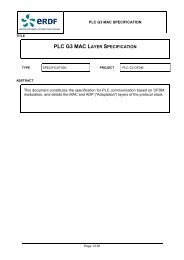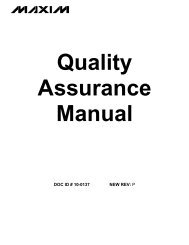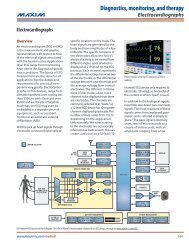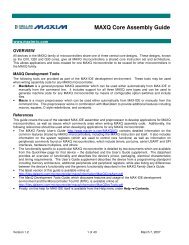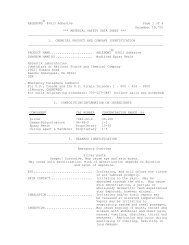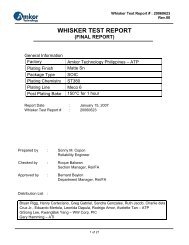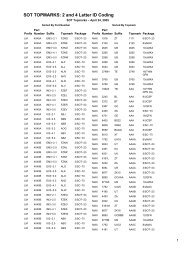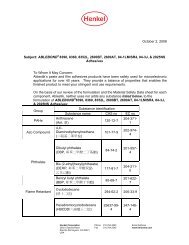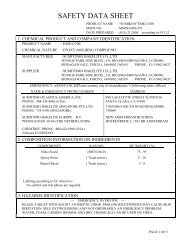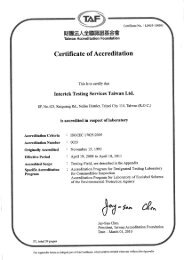Smart Grid Solutions Guide - Maxim
Smart Grid Solutions Guide - Maxim
Smart Grid Solutions Guide - Maxim
You also want an ePaper? Increase the reach of your titles
YUMPU automatically turns print PDFs into web optimized ePapers that Google loves.
CommunicationsOverviewCommunicationsOverviewAn electricity grid without adequatecommunications is simply a power“broadcaster.” It is through theaddition of two-way communicationsthat the power grid is made “smart.”Communications enables utilities toachieve three key objectives: intelligentmonitoring, security, and loadbalancing. Using two-way communications,data can be collected fromsensors and meters located throughoutthe grid and transmitted directlyto the grid operator’s control room.This added communications capabilityprovides enough bandwidth forthe control room operator to activelymanage the grid.The communications must bereliable, secure, and low cost.The sheer scale of the electricalgrid network makes cost a criticalconsideration when implementinga communications technology.Selecting a solution that minimizesthe number of modems and concentratorsneeded to cover the entiresystem can dramatically reduce infrastructurecosts. At the same time,the selected technology must haveenough bandwidth to handle all datatraffic being sent in both directionsover the grid network.Communications networksand protocolsCommunications in the smart gridcan be broken into three segments.Wide area network (WAN) coverslong-haul distances from thecommand center to local neighborhoodsdownstream.Neighborhood area network (NAN)manages all information betweenthe WAN and the home area networkusing medium-voltage lines.Home area network (HAN) extendscommunication to endpoints withinthe end-user home or business.Each segment is interconnectedthrough a node or gateway: aconcentrator between the WAN andNAN and an e-meter between theNAN and HAN. Each of these nodescommunicates through the networkwith adjacent nodes. The concentratoraggregates the data from themeters and sends that informationto the grid operator. The e-metercollects the power-usage data of thehome or business by communicatingwith the home network gateway orfunctioning as the gateway itself.Each segment can utilize differentcommunications technologies andprotocols depending on the transmissionenvironments and amountof data being transmitted. In additionto the architecture choice betweenwireless and powerline communications(PLC), there are a variety ofwireless and PLC protocols to chooseamong (Table 1).AC LINEPOWERLINECOMMUNICATIONSINBOUNDOUTBOUNDPOWERLINECOMMUNICATIONSAC LINEMODEMMODEMDC-DCDC-DCSERIALMULTIPROTOCOLRS-232 RS-485OTHERMETERSTRANSFORMER DRIVERWIRELESSCOMPLETE RF TRANSCEIVERCOMPLETE RF TRANSCEIVERWIRELESSADCADCANTENNADC-DCSWPALNADRIVERUP-CONVERTERDOWN-CONVERTERUP-CONVERTERADCDACDACMAXIMSOLUTIONADCDACDACDOWN-CONVERTERLNADRIVERPASWDC-DCANTENNA<strong>Maxim</strong> offers solutions for powerline, wireless, and serial communications. For a list of <strong>Maxim</strong>'s recommended solutions, please go to: www.maxim-ic.com/communications.www.maxim-ic.com/smartgrid 25




